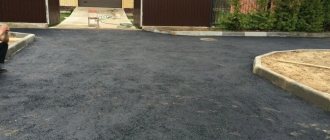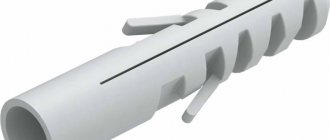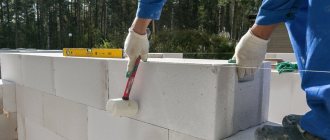October 8, 2021
Cold asphalt was invented to quickly fill potholes and cracks in the road. Even if the thermometer says -30, and you only have an hour. Then it turned out that the ready-made mixture is excellent for paving private areas and secondary roads. And because the mixture itself costs more than conventional asphalt but requires less installation costs, the result is less expensive than traditional hot paving.
Next we will talk in more detail about cold asphalt: how to lay it, what it consists of and what are the advantages.
Types of cold asphalt
We are used to thinking that there is one type of cold asphalt, but there are two:
- Standard, which is packaged in 25–30 kg. Sometimes sold in bulk, it does not require heating or the use of complex equipment.
- Hot. It contains plasticizers that liquefy bitumen even at low temperatures, which allows you to work in cold weather. Laying is done in a heated form - from 80 to 140 degrees.
We will only talk about the classic mixture, as well as in what cases and how to lay cold asphalt if you have to:
- Pothole repair of roads.
- Asphalting of private areas.
- Urgent local repairs on major highways.
- Reconstruction of the canvas after the creation of drains, repairs in the area of sewer hatches.
Content:
- What is liquid (cold, cast) asphalt?
- Pothole repair technology with liquid asphalt
- Can be leveled manually
- Delivery options
- Pit cutting
- Laying process
- How to Repair Small Potholes and Cracks
- Preparing the mixture in a recycler
Any road, like all engineering structures, has its own service life. During operation, it experiences various impacts and gradually deteriorates: various defects and deformations appear. One of the best ways to eliminate them is pothole repair with cast asphalt.
Installation materials
Before you figure out how to properly lay cold asphalt, we suggest you learn more about what it consists of.
Depending on the task, you can use only cold asphalt concrete or add crushed stone with bitumen to it:
- It is necessary to carry out pothole repair on a private property or highway, and the depth of damage is up to 20 cm. Only cold asphalt is required.
- The situation is similar, but the depth of the pothole is more than 20 cm. In this case, you will need to additionally purchase bitumen and crushed stone.
Crushed stone
If the hole is deep, it should be partially filled with crushed stone. This way you will spend less mixture, and the quality will only improve. After all, crushed stone improves the adhesion of the layers of the road “pie”, gives strength, and will not allow the coating to sag under moving vehicles.
Crushed stone comes in different fractions: 5–10, 5–20, 5–25, 10–20, 20–40 mm. When laying, you need to use several different fractions together: the large one will provide strength to the future foundation, the fine one will fill the voids.
Suitable rocks are granite or crushed limestone. It is not advisable to purchase more expensive types for pothole repair. Be sure to look at the strength indicators - marked “M”. The ideal option is M600 (average) and more.
Bitumen
This is a binding component that increases adhesion between crushed stone and an asphalt patch.
Slow-thickening (MG), partially oxidized (MGO) and medium-thickening (SG) brands performed best. The numbers indicated on the label determine the viscosity ranges. For warm regions this range should be 40/70, for cold regions - 130/20. In temperate climates, 70/130 will be optimal.
Sometimes an emulsion is used. This is still the same bitumen, but with the addition of water and emulsifiers. It is convenient to spray. The advantage is that the substance does not ignite, behaves well in cold weather, and provides reliable adhesion. When you need to save money and repair small cracks, you use tar, an oil refining product.
Cold asphalt
Unlike hot mixtures, the amount of bitumen is smaller - only 4-6%, but it is necessarily a liquid substance with low viscosity. The composition includes plasticizers and solvents that provide adhesive processes even in cold weather.
According to the size of the fractions, the mixture can be fine-grained (up to 20 mm) and sandy (up to 5 mm). The first option is considered more durable and is suitable for patching roads, parking lots, and sidewalks. The second is usually used for leveling and filling small areas.
Installation time
The key advantage is that the laying of cold asphalt is not dependent on the weather:
- Temperature range - from –30 to +40 degrees. Plasticizers allow you to liquefy bitumen even in extreme frost.
- Weather conditions: Should be relatively dry. This means that work cannot be carried out in rain or snow. But immediately after their completion, installation can begin. Wet surfaces can be dried using a hair dryer.
- Laying in a hole with a small amount of water is allowed. The quality and durability of the coating will be worse, but if repairs need to be carried out right now, such a solution will be advisable.
Pit cutting
Preparation of cards for pothole repair with liquid asphalt is standard and is carried out using equipment and tools. Basic requirements: creating vertical edges, completely removing the old canvas, cutting off sharp corners.
However, there are several nuances:
- The cut cards should be no more than 3 square meters in area, since the molded compound provides smoothness, it can significantly lengthen the braking distance. If the wheels of one vehicle axle, during braking, encounter areas with different friction coefficients, the vehicle will simply skid. A way out may be to cover the not yet hardened top layer with fine crushed stone.
- The substance adheres reliably to wet surfaces, so you don’t have to wait for the cut out part to completely dry. It is enough to remove water so that steam bubbles do not affect the structure of the hardened composition.
It is worth noting that if the material is not delivered ready-made, but is to be heated in a recycler, it would be more reasonable to carry out cutting and preparation in parallel with the heating of the raw materials. This is very convenient, because by correctly distributing workers, you can avoid possible downtime.
Step by step laying of asphalt
To give you an idea of what the asphalt paving process looks like, we will take a detailed look at the technology of laying cold asphalt.
Step 1. Remove debris and pieces of asphalt
First we remove large debris. After this, it will become clear how big the damage is and how to trim the edge. You will also be able to understand how deep the hole is in order to decide whether you need to fill it with crushed stone or not.
Step 2. Align the edges of the hole
If the damage is minor, it is not necessary to align the edges. If the hole is large, trimming the edges is indispensable. This way you can increase the stability of the applied patch. Trimming is done at a 90 degree angle with a hand grinder or road saw. It is best to trim the edges so that the patch has a relatively correct shape.
Step 3. Clean from dust and sand
When pruning is complete, you need to remove all debris and dust. The cleaner the surface, the higher the adhesion between the patch and the old road surface. Therefore, dust is removed with vacuum cleaners, and in some cases with a water jet. It is normal for some liquid to remain at the bottom. This will not affect the quality of future coating and grip.
Step 4. Cover with crushed stone
If the hole reaches a depth of 20 cm or more, it is filled with crushed stone approximately halfway. A stone pad guarantees strength and stability, and will also allow you to use less asphalt.
Step 5. Treat with bitumen
The cold asphalt installation method sometimes involves treating with bitumen. If the hole was large and had to be filled with crushed stone, it is necessary to increase the adhesive properties of the patch. To do this, the edges of the pit and the crushed stone cushion are treated with bitumen, bitumen emulsion or tar.
The most commonly used is bitumen. Its consumption is 300–500 ml per 1 square. m. For a small hole - about 100–200 ml.
Step 6. Add the mixture
If the repair is carried out in winter, and the bag was in a cold room, it is better to warm it up to 15–25 degrees. Be sure to knead the bag to make the asphalt moveable. After this, you can pour the mixture onto the road.
Your task is to evenly distribute the mixture and level it. This is quite easy to do, both with your hands and with available materials: timber, shovel, hoe. Be sure to pour the mixture with a margin of 1 cm for every 5 cm in height. The material shrinks gradually, and if you don’t leave a couple of centimeters in reserve, the patch may sag.
The thickness of the asphalt layer is made up to 5 cm. If this is not enough, laying is carried out in two layers: each 5 cm with careful compaction.
For reference!
Let's calculate the amount of mixture that will be required to pave an area of 1 cubic meter. m.
For a layer of 50 mm, 0.05 cubic meters is required. However, the material is sold in bags, so the cubes need to be converted to kilograms. To do this, you will need to know the bulk density of the mixture - 2300 kg / cubic meter. m.
We convert cubes into kilograms using the formula: For a 50 mm layer: 0.05 × 2300 = 115 kg of cold asphalt. To more accurately calculate volumes, please contact our consultants.
Step 7. Compact thoroughly
Another key point in the scheme on how to work with cold asphalt is compaction. Compaction does not require the use of heavy and expensive equipment. Suitable:
- manual rammer;
- vibrating plate;
- automobile.
You can manually compact small holes up to 0.5 square meters. m. If the patch is larger, it is better to take a vibrating plate or use a car.
Compaction is carried out in a spiral - from the edge to the center of the pit. It is advisable to walk the tool or car wheels over the surface of the patch at least 10 times. Make sure that after compaction the patch protrudes 0.5 cm above the asphalt surface.
Finally, the coating should be sprinkled with sand. This is done so that during operation there are no traces left on the surface from the wheels of a car, bicycle, scooter or shoes.
Preparing the mixture in a recycler
During the cold season at sub-zero temperatures, the composition is prepared at the work site in a recycler. It is a trailer on wheels that creates the necessary degree of heating and ensures thorough mixing of the material.
The process is divided into several stages:
- the barrel of the device is turned with the entrance hatch up, asphalt and a certain amount of bitumen are loaded into it;
- close the loading hatch tightly and turn on the nozzle. The movement of the drum should be uniform in both directions. When mixing, it is necessary to control the degree of heat of the internal contents;
- at optimal heating, turn off the burner, constantly monitoring the initial temperature;
- Having brought the recycler to the site, the drum is turned over. Opening the hatch below, unload the finished mass, then begin laying and leveling.
As the recycler moves, the drum rotates continuously. When the temperature inside decreases, the burner turns on again. It maintains the working mixture in the required technical condition.
Cast asphalt is the most modern method of creating and restoring a road, characterized by an excellent level of strength and resistance to fairly large loads and temperature changes, various types of mechanical and chemical influences, and high humidity. With full compliance with the technology and proper operation, the repaired route can last a long time without changing its quality and technical characteristics.
Features of cold asphalting
Many of our clients are interested in how cold asphalt is laid, what nuances and advantages the technology has:
- Installation in a short time. It will only take you a few hours to prepare the base, and then distribute the mixture and compact it with a manual vibratory roller or a car.
- No preparation needed. The cold mixture is simply poured into a hole or onto the surface of the earth.
- No heavy equipment. Hiring special equipment is a costly undertaking. To compact cold asphalt concrete, it is enough to rent a manual vibrating plate or use your car.
- In any weather. The mixture can be laid in weather from –30 to +40 degrees. The main thing is that it is not raining or snowing outside.
- Easy to store. You can keep asphalt in a bag for 10 years, 2 years - in any weather conditions.
- No skills required. You don't need to be a builder to lay a garden path using the cold paving method.
Garden plot
Technological progress has a beneficial effect on all areas of activity of modern man.
The production of building materials is no exception, and the development of completely new types of construction products today has an ever-increasing dynamic. Drywall, laminate, Lego brick, plastic windows, LED lighting - this is not a complete list of innovative products, without which it is difficult to imagine the construction industry today.
Similar developments include cold asphalt - a modern building material designed to cover road surfaces without the use of expensive preparatory equipment.











